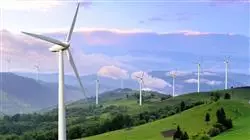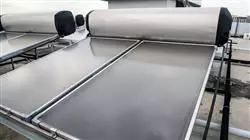University certificate
Scientific endorser

The world's largest faculty of engineering”
Introduction to the Program
An essential program for professionals in the Renewable Energies sector, which will allow you to acquire or expand the most innovative knowledge in this field"

This program is designed as a compendium of the knowledge and updates currently demanded and required by engineering, project consultancy and operation companies in Renewable Energies. A preparatory need that, once acquired, will allow the professionals to open a niche in the market and improve their professional stability.
This update will also help the student to understand in depth the situation of the world energy market and its regulatory framework at the international level, as well as the different parties involved in the financing, management and operation of Renewable Energies projects. It will also help the engineer to recognize the different international renewable technologies in this field.
In parallel, the student's managerial skills and abilities will be developed and enhanced. This will be the main basis for the engineering professional when working in the renewable energy sector in positions of high responsibility.
For all these reasons, this Professional master’s degree in Renewable Energies will provide with thorough knowledge of the global context, as well as the technical, managerial and economic aspects of the complete cycle of Renewable Energy projects. With this knowledge, the student will be highly competitive in the Renewable Energy industry.
In addition, we have included access to 10 exclusive and complementary Masterclasses, delivered by a prestigious and internationally renowned professor, specialized in Innovation and Renewable Energies and with a remarkable and successful curriculum behind him. Thanks to his guidance, students will acquire the knowledge and skills to excel in this important and in-demand field.
Apply the latest advances in Renewable Energies in your daily practice and give your resume a boost in value"
This Professional master’s degree in Renewable Energies contains the most complete and up-to-date program on the market. The most important features include:
- The development of case studies presented by experts in Renewable Energies
- The graphic, schematic, and practical contents with which they are created, provide scientific and practical information on the disciplines that are essential for professional practice
- Practical exercises where self-assessment can be used to improve learning
- Its special emphasis on innovative methodologies
- Theoretical lessons, questions to the expert, debate forums on controversial topics, and individual reflection assignments
- Content that is accessible from any fixed or portable device with an Internet connection
With the quality of a teaching method created to combine efficiency and flexibility, giving the professional all the options to achieve their goals with comfort and effectiveness"
The program's teaching staff includes professionals from the sector who bring the experience of their work to this specialization, in addition to renowned specialists from reference societies and prestigious universities.
Its multimedia content, developed with the latest educational technology, will allow the professional a situated and contextual learning, that is, a simulated environment that will provide an immersive refresher programmed for preparing in real situations.
This program is designed around Problem-Based Learning, whereby the professional must try to solve the different professional practice situations that arise during the program. For this purpose, the professional will be assisted by an innovative interactive video system created by renowned and experienced experts.
An intensive review that includes the study of the legislation related to Renewable Energies and how its application determines the current development of new projects"

Learn and analyze the latest techniques and developments implemented in this sector at international level, through a high-impact update"
Why study at TECH?
TECH is the world’s largest online university. With an impressive catalog of more than 14,000 university programs available in 11 languages, it is positioned as a leader in employability, with a 99% job placement rate. In addition, it relies on an enormous faculty of more than 6,000 professors of the highest international renown.

Study at the world's largest online university and guarantee your professional success. The future starts at TECH”
The world’s best online university according to FORBES
The prestigious Forbes magazine, specialized in business and finance, has highlighted TECH as “the world's best online university” This is what they have recently stated in an article in their digital edition in which they echo the success story of this institution, “thanks to the academic offer it provides, the selection of its teaching staff, and an innovative learning method aimed at educating the professionals of the future”
A revolutionary study method, a cutting-edge faculty and a practical focus: the key to TECH's success.
The most complete study plans on the university scene
TECH offers the most complete study plans on the university scene, with syllabuses that cover fundamental concepts and, at the same time, the main scientific advances in their specific scientific areas. In addition, these programs are continuously being updated to guarantee students the academic vanguard and the most in-demand professional skills. In this way, the university's qualifications provide its graduates with a significant advantage to propel their careers to success.
TECH offers the most comprehensive and intensive study plans on the current university scene.
A world-class teaching staff
TECH's teaching staff is made up of more than 6,000 professors with the highest international recognition. Professors, researchers and top executives of multinational companies, including Isaiah Covington, performance coach of the Boston Celtics; Magda Romanska, principal investigator at Harvard MetaLAB; Ignacio Wistumba, chairman of the department of translational molecular pathology at MD Anderson Cancer Center; and D.W. Pine, creative director of TIME magazine, among others.
Internationally renowned experts, specialized in different branches of Health, Technology, Communication and Business, form part of the TECH faculty.
A unique learning method
TECH is the first university to use Relearning in all its programs. It is the best online learning methodology, accredited with international teaching quality certifications, provided by prestigious educational agencies. In addition, this disruptive educational model is complemented with the “Case Method”, thereby setting up a unique online teaching strategy. Innovative teaching resources are also implemented, including detailed videos, infographics and interactive summaries.
TECH combines Relearning and the Case Method in all its university programs to guarantee excellent theoretical and practical learning, studying whenever and wherever you want.
The world's largest online university
TECH is the world’s largest online university. We are the largest educational institution, with the best and widest online educational catalog, one hundred percent online and covering the vast majority of areas of knowledge. We offer a large selection of our own degrees and accredited online undergraduate and postgraduate degrees. In total, more than 14,000 university degrees, in eleven different languages, make us the largest educational largest in the world.
TECH has the world's most extensive catalog of academic and official programs, available in more than 11 languages.
Google Premier Partner
The American technology giant has awarded TECH the Google Google Premier Partner badge. This award, which is only available to 3% of the world's companies, highlights the efficient, flexible and tailored experience that this university provides to students. The recognition as a Google Premier Partner not only accredits the maximum rigor, performance and investment in TECH's digital infrastructures, but also places this university as one of the world's leading technology companies.
Google has positioned TECH in the top 3% of the world's most important technology companies by awarding it its Google Premier Partner badge.
The official online university of the NBA
TECH is the official online university of the NBA. Thanks to our agreement with the biggest league in basketball, we offer our students exclusive university programs, as well as a wide variety of educational resources focused on the business of the league and other areas of the sports industry. Each program is made up of a uniquely designed syllabus and features exceptional guest hosts: professionals with a distinguished sports background who will offer their expertise on the most relevant topics.
TECH has been selected by the NBA, the world's top basketball league, as its official online university.
The top-rated university by its students
Students have positioned TECH as the world's top-rated university on the main review websites, with a highest rating of 4.9 out of 5, obtained from more than 1,000 reviews. These results consolidate TECH as the benchmark university institution at an international level, reflecting the excellence and positive impact of its educational model.” reflecting the excellence and positive impact of its educational model.”
TECH is the world’s top-rated university by its students.
Leaders in employability
TECH has managed to become the leading university in employability. 99% of its students obtain jobs in the academic field they have studied, within one year of completing any of the university's programs. A similar number achieve immediate career enhancement. All this thanks to a study methodology that bases its effectiveness on the acquisition of practical skills, which are absolutely necessary for professional development.
99% of TECH graduates find a job within a year of completing their studies.
Professional Master's Degree in Renewable Energies
.
The great relevance that has gained in recent times the development of renewable energy generation and management projects has led this field of engineering to stand out as one of the most important specialties today. Due to this, there is a great need in the current labor market for professionals with expertise in the development, monitoring and support of such energy projects. Understanding the role of academic updating in the training of engineers suitable for an adequate insertion in this important occupational niche, at TECH Global University we have prepared our Professional Master's Degree program in Renewable Energies. In this postgraduate program, special emphasis will be placed on the identification of the possibilities of use of the different types of synchronous and asynchronous wind generators. Likewise, the following topics will be updated: knowledge of the new technologies used in the development of medium and high temperature solar thermal systems, followed by the identification of the particularities or aspects to be taken into account in the design and installation of a biomass energy system.
Study an online Professional Master's Degree in renewable energies
.
The development of renewable energy projects requires the monitoring and control of a long list of elements and technological, environmental and legal factors, being necessary for its management the presence of specialized professionals with a high degree of preparation. In our Professional Master's Degree program you will approach renewable energies from the identification of their new development paths, contemplating the new scopes of implementation of the sector. Likewise, in this postgraduate program you will delve into the modernization of the following aspects: the identification of the legal, normative and legislative regulations regarding the development of renewable energy projects and the knowledge of the main operational characteristics of the types of hydroelectric power plants.







